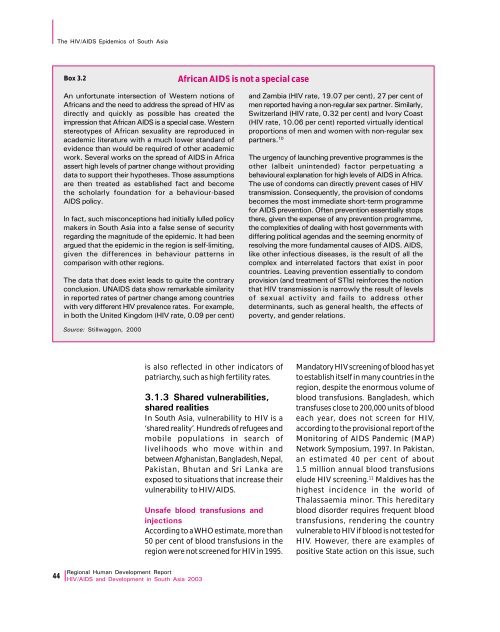Download Report - UNDP Asia-Pacific Regional Centre - United ...
Download Report - UNDP Asia-Pacific Regional Centre - United ...
Download Report - UNDP Asia-Pacific Regional Centre - United ...
You also want an ePaper? Increase the reach of your titles
YUMPU automatically turns print PDFs into web optimized ePapers that Google loves.
The HIV/AIDS Epidemics of South <strong>Asia</strong>Box 3.2African AIDS is not a special caseAn unfortunate intersection of Western notions ofAfricans and the need to address the spread of HIV asdirectly and quickly as possible has created theimpression that African AIDS is a special case. Westernstereotypes of African sexuality are reproduced inacademic literature with a much lower standard ofevidence than would be required of other academicwork. Several works on the spread of AIDS in Africaassert high levels of partner change without providingdata to support their hypotheses. Those assumptionsare then treated as established fact and becomethe scholarly foundation for a behaviour-basedAIDS policy.In fact, such misconceptions had initially lulled policymakers in South <strong>Asia</strong> into a false sense of securityregarding the magnitude of the epidemic. It had beenargued that the epidemic in the region is self-limiting,given the differences in behaviour patterns incomparison with other regions.The data that does exist leads to quite the contraryconclusion. UNAIDS data show remarkable similarityin reported rates of partner change among countrieswith very different HIV prevalence rates. or example,in both the <strong>United</strong> Kingdom (HIV rate, 0.09 per cent)and Zambia (HIV rate, 19.07 per cent), 27 per cent ofmen reported having a non-regular sex partner. Similarly,Switzerland (HIV rate, 0.32 per cent) and Ivory Coast(HIV rate, 10.06 per cent) reported virtually identicalproportions of men and women with non-regular sexpartners. 10The urgency of launching preventive programmes is theother (albeit unintended) factor perpetuating abehavioural explanation for high levels of AIDS in Africa.The use of condoms can directly prevent cases of HIVtransmission. Consequently, the provision of condomsbecomes the most immediate short-term programmefor AIDS prevention. Often prevention essentially stopsthere, given the expense of any prevention programme,the complexities of dealing with host governments withdiffering political agendas and the seeming enormity ofresolving the more fundamental causes of AIDS. AIDS,like other infectious diseases, is the result of all thecomplex and interrelated factors that exist in poorcountries. Leaving prevention essentially to condomprovision (and treatment of STIs) reinforces the notionthat HIV transmission is narrowly the result of levelsof sexual activity and fails to address otherdeterminants, such as general health, the effects ofpoverty, and gender relations.Source: Stillwaggon, 2000is also reflected in other indicators ofpatriarchy, such as high fertility rates.3.1.3 Shared vulnerabilities,shared realitiesIn South <strong>Asia</strong>, vulnerability to HIV is a‘shared reality’. Hundreds of refugees andmobile populations in search oflivelihoods who move within andbetween Afghanistan, Bangladesh, Nepal,Pakistan, Bhutan and Sri Lanka areexposed to situations that increase theirvulnerability to HIV/AIDS.Unsafe blood transfusions andinjectionsAccording to a WHO estimate, more than50 per cent of blood transfusions in theregion were not screened for HIV in 1995.Mandatory HIV screening of blood has yetto establish itself in many countries in theregion, despite the enormous volume ofblood transfusions. Bangladesh, whichtransfuses close to 200,000 units of bloodeach year, does not screen for HIV,according to the provisional report of theMonitoring of AIDS Pandemic (MAP)Network Symposium, 1997. In Pakistan,an estimated 40 per cent of about1.5 million annual blood transfusionselude HIV screening. 11 Maldives has thehighest incidence in the world ofThalassaemia minor. This hereditaryblood disorder requires frequent bloodtransfusions, rendering the countryvulnerable to HIV if blood is not tested forHIV. However, there are examples ofpositive State action on this issue, such44<strong>Regional</strong> Human Development <strong>Report</strong>HIV/AIDS and Development in South <strong>Asia</strong> 2003
















